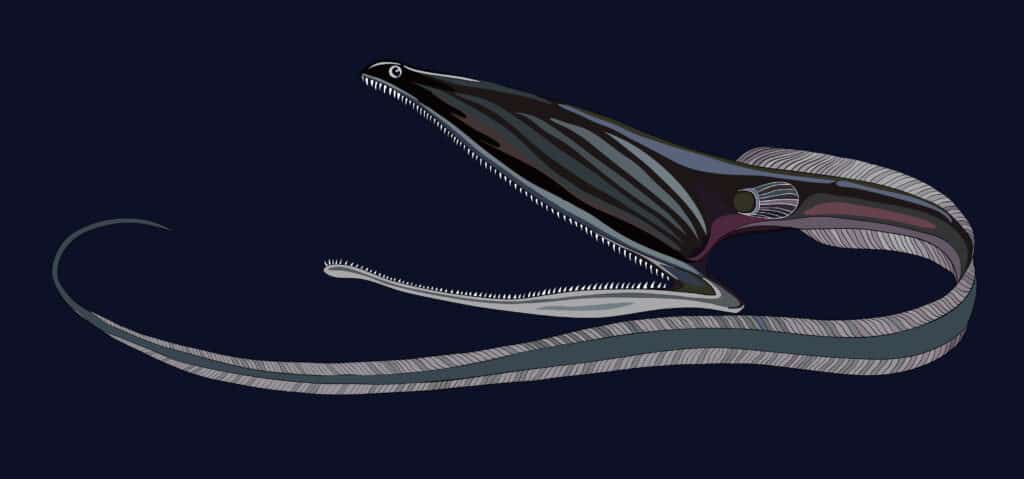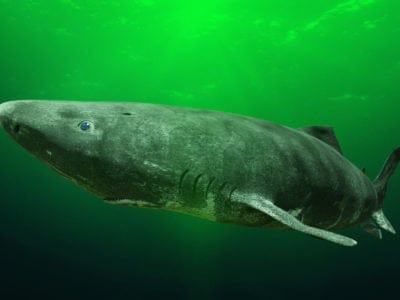Gulper eels have a similar lifespan to humans and can live up to 85 years old. However, their age depends on their habitat and the availability of food.
Advertisement
Gulper Eel Scientific Classification
- Kingdom
- Animalia
- Phylum
- Chordata
- Class
- Actinopterygii
- Order
- Anguilliformes
- Family
- Eurypharyngidae
- Genus
- Eurypharynx
- Scientific Name
- Eurypharynx pelecanoides
Read our Complete Guide to Classification of Animals.
Gulper Eel Conservation Status
Gulper Eel Facts
- Prey
- Cephalopods, Shrimps, Small Invertebrates
- Group Behavior
- Solitary
- Fun Fact
- Gulper eels have a similar lifespan to humans and can live up to 85 years old. However, their age depends on their habitat and the availability of food.
- Other Name(s)
- Pelican Eel
Gulper Eel Physical Characteristics
- Color
- Black
- White
- Olive
- Skin Type
- Smooth
- Aggression
- High
View all of the Gulper Eel images!
The gulper eel (Eurypharynx pelecanoides) is a strange-looking fish that inhabits the deep sea. Its most distinctive feature is its enormous mouth. Their mouth is much bigger than their bodies, making them appear disproportionate.
Their mouth opens wide enough to swallow animals much bigger than themselves, almost like it’s hinged. Then, the prey is deposited into a pouch-like lower jaw that resembles a Pelican, which is why they are also called the Pelican Eel.
Their bodies are equipped to accommodate any large meals because their stomachs can stretch. Because of this trait, they are also often referred to as the umbrella mouth gulper.
Gulper eels occur in every tropical and temperate ocean in the world, but because they inhabit the deepest waters, most of the information on record comes from gulpers caught in deep sea fishing nets.
Three Amazing Gulper Eel Facts!
- The stomach of the Pelican eel can stretch to accommodate large amounts of food. However, despite this, they primarily eat small crustaceans.
- Their mouths work like nets when they swim through large schools of shrimp and small fish. In addition to catching prey, their mouths fill with water, which is slowly released through their gill slits.
- Adult males have larger eyes and olfactory organs once they sexually mature, while females don’t change. But, males need these changes for reproduction because it helps them detect the pheromones released by females. In addition, researchers believe that the gulper eel dies after reproduction.
Gulper Eel Scientific Name
The Gulper eel’s scientific name is Eurypharynx pelecanoides, and they belong to the Order Anguilliformes. They are also known as Apodes, which means “limbless,” because they don’t have protruding fins.
They are members of the Eurypharyngidae family, which are deep-sea fish that have huge mouths. Gulper eels’ mouths are so big that they can swallow prey bigger than them.
While they have large heads, their bodies taper down into a very narrow tail region. These eels live at depths of 6500 feet, so it’s thought their large mouths are an adaptation to the scarceness of food at those depths.
Contrary to popular belief, Pelican eels are not large fish and rarely exceed 24 inches in length.
Gulper Eel Appearance

The gulper eel is easily distinguished from other eel species because of its large mouth.
©Panaiotidi/Shutterstock.com
The gulper eel is easily distinguished from other eel species because of its large mouth. However, there are other characteristics that set it apart.
Their tiny pectoral fins are so small that they are hardly visible. In addition, gulper eels have really small eyes, which researchers believe evolved to detect faint traces of light instead of forming images. They also have elongated, whip-like tails.
Their long tails end in a light-producing organ called the photomore. This organ glows pink and occasionally flashes red. This is a trait they use for hunting purposes because they are not very fast swimmers, so instead, they make the prey come to them.
Once their prey is close enough to their massive mouths, they will snap them up. They vary in length from 3 to 6 feet and are generally dark green or black in color. Sometimes they have a white line of dentation on the sides of their dorsal fin. The Gulper eel weighs around 20 pounds.
Gulper Eel Behavior
Pelican eels go by many names, but the most fitting is the umbrella-mouth gulper because of the way their mouths blow up, creating a new that scoops up small fish or squid.
This balloon-like capacity is really beneficial for opportunistic feeders. Without this function, the gulper’s tiny teeth would never be able to do the job alone.
Although their mouths make them look fierce, they are relatively weak hunters. Gulper eels have incredibly small eyes compared to other species occupying the deep ocean. So, they have to rely on their photomore located at the tip of their tail to lure in prey.
In addition, they are not very good swimmers because of their whip-like tails and lack of pelvic fins. This could be why these mysterious creatures remain at depths of 3000 to 6000 feet. These eels spend most of their time drifting around the deep, but they are not being lazy; they are conserving their energy to find a mate.
Adult males have larger olfactory organs (which are responsible for smell), which helps them locate females. Unfortunately, while this is happening, they start to lose their teeth. Researchers think that this happens because they put all their resources into reproduction. In addition, they believe that gulper eels die soon after mating.
Gulper Eel Habitat
Gulper eels inhabit the deep ocean waters at around 3000 to 6000 feet. Because the sun does not penetrate that far, the water is pitch black, so they have certain adaptations to help them survive there with minimal food sources.
Gulper Eel Diet
Their primary food source is crustaceans. Due to the enormous size of their mouths, they can eat a considerable amount in one sitting, so they often prey on groups of:
Gulper Eel Predators and Threats
Gulper eels are preyed on by deep-sea predators like lancetfish but don’t have many predators at the depths they inhabit.
They have no significant threats, and they are not consumed by humans. However, they can be dangerous to people. They can shock humans, but their voltage is not fatal. However, if shocked multiple times, it can lead to severe damage and, in rare cases, death.
Their population seems stable now, and they are listed as Least Concern on IUCN’s Redlist.
Gulper Eel Reproduction, Babies, and Lifespan
There is very little information about the reproductive habits of the Gulper eel. Just like other eels, when they are first born, they begin in the leptocephalus stage (thin and transparent). Before reaching the juvenile stage, they don’t contain any red blood cells, and their body organs are tiny.
As males start to mature, they begin to change, and their olfactory organs start to enlarge, which in turn, causes their teeth to fall out. In addition, male Gulper eels have defined reproductive organs. During reproduction, males’ testes occupy most of the space in their stomach cavity, and the stomach shrinks. However, females don’t seem to change at all once they sexually mature.
Males enlarged olfactory organs help them locate the females who release a pheromone into the ocean. Many researchers think that gulper eels die shortly after reproduction. In addition, they only reproduce later in life, which is believed to be a strategy that increases offspring survival.
Lifespan/Longevity
Gulper eels have a similar lifespan to humans and can live up to 85 years old. However, their age depends on their habitat and the availability of food.
Gulper Eel Population
Unfortunately, there is no information on the Gulper eels’ population size because their habitat is inaccessible to humans. However, the IUCN has listed its population as stable.
Four Species Similar to the Gulper Eel
There are around 800 species of eel on the planet, but there are four species that are incredibly similar to the Gulper eel; they include:
Whiptail Gulper
The whiptail gulper inhabits the depths of the eastern Pacific Ocean and lives at 6500 to 10,000 feet below the surface. Food is a rare commodity at those depths, and predators must take the opportunity whenever it comes around.
Like the Gulper eel, the Whiptail has a giant mouth, which it uses to swallow large prey whole. They have terrible vision, but it doesn’t affect them because the depths they inhabit are pitch dark anyway.
Therefore, their eyes are small and rudimentary. They have elongated bodies, and much like the Gulper eel, they have a light on the tip of their tails that they use to entice prey to come closer.
Because these eels live in the deep sea, it is tough to study them, and the data collected so far was from specimens that were caught in deep nets by accident. In fact, Whiptails have never been observed in their natural environment. In addition, it’s impossible to keep this species in captivity to study them.
Researchers seem to think that Whiptails die after reproduction like salmon, based on a specimen obtained from a deep-sea fishing excursion.
Whiptail gulpers are not edible, and there is no data to suggest that people negatively impact their populations. However, they are naturally rare, and only several specimens are available in collections worldwide.
Moray Eels
Moray eels belong to the Muraenidae family and prefer to inhabit diverse habitats in tropical or temperate ocean waters. There are 220 species and 16 genera in this family. Their distinctive features include:
- A dorsal fin that runs along the entire length of their body
- Absent pectoral and anal fins
- Large faces with prominent eyes (which makes them look highly aggressive)
- Moray eels come in many colors ranging from green, black, and brown to orange and yellow
In addition, they have mucus covering their body, which helps prevent any damage to their body while they graze in the coral reefs.
Once they have the prey in their mouths, they use their pharyngeal jaws to gut the prey down their throats.
Their diet consists of small fish that inhabit the ocean floor amongst reefs, crustaceans, and squid. They are preyed upon by creatures like sea snakes, barracudas, groupers, and sharks.
Slender Giant Moray
The Slender giant moray’s scientific name is Strophidon sathete, also called the Gangetic moray. They are the longest species of the moray eel family. These long eels are brownish-gray and are native to the:
- Indo-Pacific Ocean
- Red Sea
- East Africa
- Western Pacific
Slender giant morays tend to gravitate to muddy environments of marine waters, rivers, estuaries, and inner bays.
The slender giant moray is often mistaken for the Giant moray; however, they have several different characteristics that help to tell them apart. The most significant difference between the two species is their size. While the Giant moray weighs more than the Slender moray, the latter is the longest between the two.
All members of moray eels (220 species) are exclusively confined to oceans, saltwater or shallow water lakes, marine areas, and inner bays.
Both species are apex predators and prey on marine creatures like
The slender giant moray lives at depths of 49 feet and their elongated bodies are tapered at the tails. They are not the friendliest animals and are generally really shy. Because they are so elusive, there is not a lot of information about their reproduction behavior. Slender morays inhabit the deep coral reefs of the Pacific Ocean, which is another reason why they are so hard to observe.
American Eel
At first glance, American eels appear naked, but their slender, snake-like bodies are enveloped in a mucus layer, making them appear slimy and smooth, despite the presence of minute scales.
Like most eels, they have a long dorsal fin that runs down the entire length of their bodies and is continuous with a ventral fin. However, American eels don’t have pelvic fins, and their pectoral fins are relatively small and located near the midline, which is succeeded by their heads and gill covers.
American eels come in various colors, from brown shading to greenish-yellow, olive green, and light gray or white on the belly. Eels from dark, tannic acid streams are usually darker than those from clear water.
These eels only inhabit freshwater sources and estuaries but will leave these areas to enter the Atlantic Ocean for spawning migration to the Sargasso Sea.
American eel’s spawning occurs far into the ocean, where the eggs will hatch. Astonishingly, females can lay up to 4 million buoyant eggs and sadly die afterward.
Once the eggs hatch, the larvae start to develop into organisms called leptocephali. These juvenile eels begin to migrate towards North America, where they develop into glass eels, and head back to freshwatersystems, where they grow and turn into adults.
What’s Up Next?
View all 178 animals that start with GGulper Eel FAQs (Frequently Asked Questions)
How big do gulper eels get?
Gulper eels weigh around 20 pounds.
What can a gulper eel do?
They can shock humans, but their voltage is not fatal. However, if shocked multiple times, it can lead to severe damage and, in rare cases, death.
What is the difference between a gulper eel and a pelican eel?
There are no differences between the Gulper and Pelican eel because they are the same animal.
Are gulper eels blind?
No, but they have poor eyesight.
Thank you for reading! Have some feedback for us? Contact the AZ Animals editorial team.
Sources
- Seasky / Accessed August 28, 2022
- Animal Sake / Accessed August 28, 2022
- Kidadl / Accessed August 28, 2022
- Ocean Conservancy / Accessed August 28, 2022
- Wikipedia / Accessed August 28, 2022
















